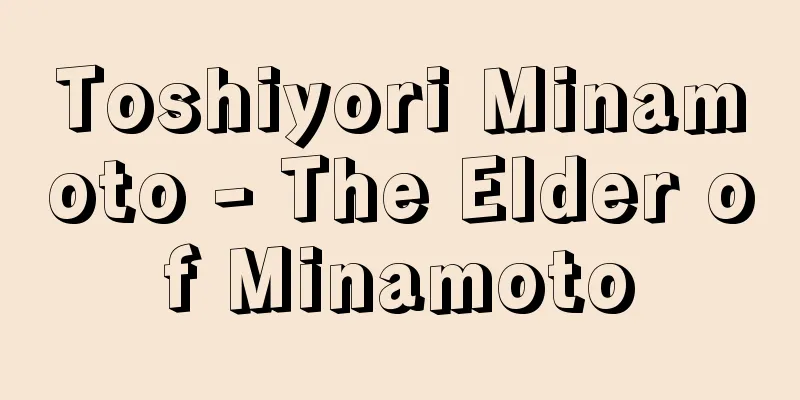Toshiyori Minamoto - The Elder of Minamoto

|
Year of death: 1128,9 Year of birth: Tenki 3 (1055) A poet of the late Heian period. His father was Minamoto no Tsunenobu, a Grand Minister of Second Rank. His mother was the daughter of Tosa no Kami Minamoto no Sadasuke. His sons Toshige, Toshie, Toshimori, Sukemori, and Taikenmon'in Shinshosho were also imperially commissioned poets. He studied waka poetry under his father Tsunenobu, and was adopted by the wealthy Tachibana no Toshitsuna in his teens, and is thought to have been influenced by the poets who gathered at the Fushimitei poetry gatherings. He served as a musician at the Shoryaku Imperial Palace poetry contests. He was not included in the Goshuishu. After appearing at the Shijo Palace fan-festival in 1089, he appeared at a succession of formal occasions, including the Ikuhomon'in Neai in 1089 and the Koyoin Shichiban Utaawase in 1095. In 1095, he accompanied his father Tsunenobu when he was appointed Dazai Gonsoushi. He returned to Kyoto following his father's death in 1097. On his way to Kyoto, he left behind many poems of grief, sorrow, and pain. He was then active in the poetry circles of Emperor Horikawa's palace. He participated in poetry gatherings and poetry contests hosted by Minamoto no Kuninobu and Michitoki, Fujiwara no Nakazane, Toshitada, and Kinzane, and participated in the Horikawa-in Ensho-awase in 1102. He is believed to have been one of the authors of the "Horikawa Hyakushu" and to have been deeply involved in planning and setting the questions. However, he was not blessed with a successful career in the government, and after serving as Konoe no Shosho and Sakyo Gon-no-daibu, he attained the highest rank of Jushi Shiino Jo Mokko no Kami. After the death of Emperor Horikawa, he participated in the "Eikyu Hyakushu". He also frequently participated in poetry contests hosted by the household of the Minister of the Interior Fujiwara no Tadamichi, and also served as a judge. He also frequently participated in poetry gatherings and poetry contests sponsored and supervised by Fujiwara no Akisue, such as the Jitsugyo-ke Poetry Contest in 1116, the Gajo-ke Poetry Contest in 1118, and the Hitomaro Kageku Poetry Contest in the same year, and served as a judge at the Mudoji Poetry Contest in 1122 and the Karin-in Poetry Contest in Nara in 1124. Although he rivaled Fujiwara no Mototoshi, he continued to be active as a leading figure in the poetry world. In 1189, he was ordered by Emperor Shirakawa to select the Kin'yoshu. After two revisions, the Sanso version was accepted. In his later years, he self-selected the family collection Sanki-kikashu. His poetry treatise includes Toshiyori Zuiuno. He was a great poet representing the Insei period, and had an enormous influence on later poets such as Fujiwara no Shunzei and Teika. He was able to compose a wide variety of styles, from high-level descriptive poetry inherited from his father Tsunenobu to vulgar humorous poetry, and was proactive in expanding his terminology and materials. He actively absorbed Manyo words, slang, and unusual words, and had a strong interest in historical events and legends. He placed importance on "unusual phrasing" as a requirement for a great poem (Toshiyori Zuiuno), and is said to have commented, "I am not a poet. I compose poems" (Kensho Kokin Shuchu), but it seems he had considerable pride in his own style of poetry, saying, "I will try to draw out all the words that I find emoihanu (feelings of emotion)." He also enjoyed linked verse. (Tanaka Hiroki) Source: Asahi Japanese Historical Biography: Asahi Shimbun Publications Inc. About Asahi Japanese Historical Biography |
|
没年:大治3,4(1128,9) 生年:天喜3(1055) 平安後期の歌人。父は正二位大納言源経信。母は土佐守源貞亮の娘。子の俊重,俊恵,俊盛,祐盛,待賢門院新少将も勅撰歌人。父経信に和歌を学ぶとともに,10歳代のころ富豪橘俊綱の猶子となり,伏見亭歌会に集う歌人たちに影響を受けたかと想像される。承暦内裏歌合には楽人として奉仕。『後拾遺集』にも入集しなかった。寛治3(1089)年四条宮扇合に出詠以後,寛治7年郁芳門院根合,寛治8年高陽院七番歌合などの晴儀に相次いで出詠。嘉保2(1095)年には父経信の大宰権帥赴任に同行。承徳1(1097)年父の死により帰京。上京の途次,悲嘆哀傷の歌を多く遺している。その後,堀河天皇内裏歌壇で活躍。源国信・師時,藤原仲実・俊忠・公実などが主催する歌会,歌合に参加し,康和4(1102)年堀河院艶書合に出詠。『堀河百首』の作者に入り,企画,出題に深く関与したものと推定される。その一方で官途には恵まれず,近衛少将,左京権大夫を経て従四位上木工頭を極官とする。堀河天皇の死後,『永久百首』に出詠。内大臣藤原忠通家の歌合にもたびたび参加し,判者をも務めている。また,永久4(1116)年実行家歌合,元永1(1118)年雅定家歌合,同年人麿影供など,藤原顕季が主催,後見する歌会,歌合への出詠も多く,保安3(1122)年無動寺歌合,天治1(1124)年奈良花林院歌合などの判者を務め,藤原基俊と拮抗しつつも歌壇の第一人者として旺盛な活動を続けた。天治1年には白河法皇の命を受けて『金葉集』を選進。2度の改編を経て三奏本が嘉納された。晩年には家集『散木奇歌集』を自選。歌論書に『俊頼髄脳』がある。 院政期を代表する大歌人で,藤原俊成・定家ら後代歌人への影響も甚大である。父経信譲りの長の高い叙景歌から卑俗な誹諧歌に至る多様な風体を詠み分け,用語,素材の拡充にも積極的で,万葉語,俗語,奇語を盛んに摂取し,故事,説話への関心も高かった。秀歌の要件として「珍しき節」を重視し(『俊頼髄脳』),「我ハ歌ヨミニハアラズ。歌ツクリナリ」と任じていたというが(『顕昭古今集注』),「エモイハヌ詞ドモヲトリアツメテキリクム」自らの詠法には少なからぬ自負を抱いていたと思われる。連歌をも好んだ。 (田仲洋己) 出典 朝日日本歴史人物事典:(株)朝日新聞出版朝日日本歴史人物事典について 情報 |
Recommend
How to identify -
This method of public notice has been recognized ...
Martenot, M.
...It was named after this instrument. In the sam...
Eruption - eruption
A phenomenon in which liquid and solid materials ...
McCune-Albright syndrome
…Of these, brain tumors, especially pineal tumors...
Izumoji School - Izumoji
The name of a sect of Shinshu Buddhism. Its head t...
Organelles
Also called organelles or cell organelles. Structu...
Instantaneous interruption - Shundan
A momentary interruption in the supply of electric...
migratory (traveling) anticyclone
A moving high pressure system. There are two types...
Lindbergh, AM
…After the war, he served as an adviser to the Ai...
Mother Goose's Melody
…In England, they are usually called “nursery rhy...
Prichitaniya
...Of these, wedding and funeral songs are especi...
Tsukiyo - Sakayaki
A type of hair styling method for men during the ...
Ion X-ray tube
…At the end of 1895, WC Roentgen discovered that ...
Campodea - Campodea
…General term for insects belonging to the Campod...
French Equatorial Africa - Afrique Équatoriale Française; French Equatorial Africa
A French colony in the central-western part of the...









